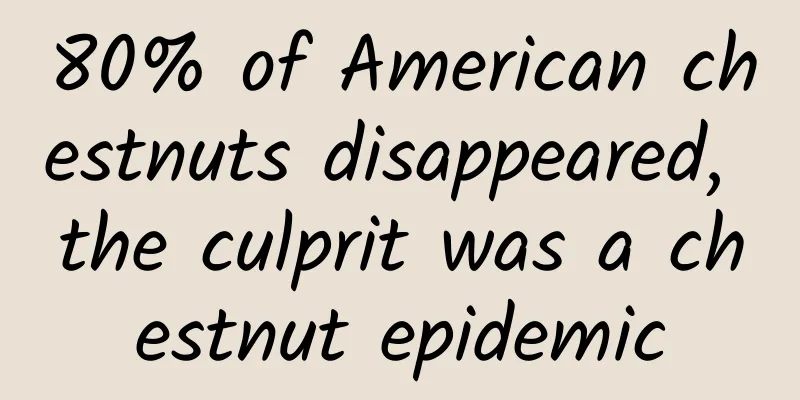80% of American chestnuts disappeared, the culprit was a chestnut epidemic

|
Produced by: Science Popularization China Author: Xiao Bai (Institute of Botany, Chinese Academy of Sciences) Reviewer: Lai Yangjun (Institute of Botany, Chinese Academy of Sciences) Producer: China Science Expo As the autumn wind blows, the earth gradually becomes colorful, and the fields are full of a scene of harvest. In this beautiful season, chestnut (Castanea mollissima) also welcomes its harvest time. As an ancient and precious fruit tree, chestnut not only provides people with delicious food, but also carries rich cultural connotations and ecological significance. Sugar-roasted chestnuts (Image source: Wikipedia) The shape of chestnut Castanea chinensis, also known as chestnut tree, is a large tree in the Fagaceae family . It can usually grow to more than 20 meters, with a straight trunk and a broad crown. The leaves of chestnut are oval, with serrated edges and a smooth and bright surface. Every spring and summer, new leaves unfold on the branches like emerald feathers, adding vitality to the entire crown. The flowers of chestnut are divided into male and female. The male flowers are small and gather together to form catkins, while the female flowers are hidden in the cupule. Male and female flowers of chestnut (Photo source: China Plant Image Library, photographed by Liu Bing) Some chestnuts have a cupule that wraps around the fruit, which is the origin of the name of the Fagaceae family to which chestnuts belong. Wen Tong, a poet and painter in the Northern Song Dynasty, described chestnuts as "big as the green thorn tree, and soft as the purple shell of betel nut." The poem says that the cupule looks like an enlarged thorn tree, the color of the fruit skin is close to that of betel nut, and the taste is soft and delicious. Chestnuts in the cupule (Photo credit: Photo by Li Wenyi) When the chestnut fruit is not yet ripe, the cupule will not split open, and the thorny cupule protects the immature seeds inside. When it is ripe, the cupule splits open to reveal the fruit inside. The hard peel is not edible, but peeling it off will reveal the chestnut kernel we often eat. Chestnut cross section (Image source: Reference 1) However, you should be extra careful when you see "chestnuts" on trees on the roadside, in parks or in the wild. There is a plant called horse chestnut (Aesculus chinensis), also known as Tianshi chestnut and monkey chestnut. Its fruit looks very similar to chestnuts, but it is poisonous. However, it does not have a cupule on the outside, and the leaves of horse chestnut and chestnut are also very different, so be careful to distinguish them. Aesculus chinensis var. wilsonii (Image source: China Plant Image Library) Chestnut Culture Compared with its closely related species, chestnut is more resistant to adversity, can adapt to different soil environments, and can survive in cold and dry climates, which creates conditions for its widespread cultivation in China. As a native tree species in my country, chestnut has a long history of cultivation, which can be traced back to the Western Zhou Dynasty. "The chestnuts at the east gate are used to cultivate the family" is recorded in "The Book of Songs·Zheng Feng·Dongmen Zhidan"; "The hazelnuts and chestnuts are planted, the tung trees and lacquer are used, and the zithers and harps are cut there" is recorded in "The Book of Songs·Zong Feng·Ding Zhi Fangzhong" which shows that chestnuts were already planted in the northern region at that time for people to obtain food and wood. In the long history of China, chestnut, as an important woody starch plant, was an important source of starch for people and provided people with high-quality wood before sweet potatoes and potatoes were introduced to China and planted on a large scale. People eat chestnuts to fill their stomachs, play chestnut-wood zithers, build houses with chestnut wood, plant chestnuts in front of and behind houses and on both sides of roads, and even use chestnuts to express the pain of lovesickness in poems. Chestnuts and people have supported each other for thousands of years, and they still do today. On the other side of the ocean, American chestnuts (Castanea dentata) were once widely distributed in the eastern United States. According to a report from the American chestnut foundation, about a hundred years ago, there were 4 billion American chestnuts in the United States. They were the dominant tree species in the eastern United States at the time, accounting for about 25% of the trees in the forest. Similar to China, locals also eat American chestnut seeds and use its high-quality wood as building materials. Chestnuts have thus become one of the symbols of local rural culture. American chestnut (Image source: Wikipedia) Picking Chestnuts (Image credit: Winslow Homer, 1870) Chestnut Blight and American Chestnut However, the American chestnut is now on the verge of extinction. It all started in the early 20th century when the United States imported chestnuts and chestnut trees from East Asia. In 1904, Herman W. Merkel, a staff member at the Bronx Zoo in New York City, discovered that a chestnut tree in the zoo had developed an ugly ulcer that penetrated deep into the cambium layer inside the trunk and quickly killed the chestnut tree. Ulcers caused by chestnut blight (early stage) (Image source: Wikipedia) In 1905, American mycologist William Murrill isolated and confirmed that a fungus widely found on chestnut trees in East Asia, Cryphonectria parasitica, was the pathogen of chestnut blight. But it was too late. Chestnut blight had spread like wildfire in the United States. People tried many methods, including drugs, burning, and cutting down trees, but still could not save the situation. By the 1920s, 80% of American chestnuts in the United States were infected with chestnut blight. In the 1940s, 80% of American chestnuts died. Because the chestnut blight fungus cannot invade the roots of American chestnuts very well, seedlings can still sprout from some of the roots that have survived. However, the fungus can infect other trees near the chestnut trees, such as oaks and beech trees, and maintain a long-term symbiotic relationship. The spores spread from these trees will infect and kill nearby American chestnut seedlings. Therefore, few American chestnuts can survive to the sexual reproduction stage and the population cannot be restored. East Asian chestnuts and Japanese chestnuts (Castanea crenata) have long lived in symbiosis with chestnut blight fungi, so some populations have developed resistance to it. Botanists in the United States have tried to cross chestnuts with American chestnuts, screen out hybrid offspring with chestnut blight resistance, and then backcross with American chestnuts in the hope of obtaining individuals with both American chestnut appearance and chestnut blight resistance , but this requires a huge amount of work and a long time. Hybrid chestnut trees at the American Chestnut Foundation's Tower Hill Botanical Gardens (Image source: Wikipedia) In the study of chestnut blight, people found that the oxalic acid content in the bark cambium of American chestnuts infected by chestnut blight fungi increased significantly. If the oxalic acid content can be reduced, the infection of chestnut blight fungi can be better resisted. With the development of gene editing technology, botanists have successfully transferred the oxalate oxidase gene of wheat into American chestnuts, making them resistant to chestnut blight. In recent years, backcrossed and gene-edited American chestnuts have been widely transplanted to the original distribution areas of American chestnut for population restoration. Protection of chestnut Although our country's chestnuts do not have the same ill-fated fate as their "relatives", if we do not attach importance to the protection of germplasm resources, perhaps one day they will encounter pathogens that they cannot resist and be at risk of extinction. As early as the Three Kingdoms period, Lu Ji commented in "Maoshi Caomu Niaoshou Chongyu Shu" that "there are chestnuts in all five directions...only the chestnuts in Yuyang and Fanyang are sweet and long-lasting." The Yuyang and Fanyang areas here are today's Beijing and Baoding. However, with the continuous expansion of human activities, some traditional chestnut forests have been gradually destroyed. Take Huairou District in Beijing as an example. The local chestnut resources have been destroyed twice. Excessive development and indiscriminate logging have caused a sharp decrease in the number of chestnut trees. A survey in 2013 showed that Beijing's ancient chestnut trees are concentrated in Huairou, with a total of 28,995 trees. However, they are still mainly sold for their fruits and lack special care. Only 60% of the ancient chestnut trees are growing well. Most of the ancient chestnut trees lack the necessary and sufficient soil, fertilizer and water management. Some plants have hollow trunks or dead branches, and some plants are seriously damaged by diseases and insect pests. In recent years, in order to protect this precious resource, people have begun to pay attention to the protection and restoration of chestnuts. Today, in the "Old Chestnut Tree" Ming and Qing Dynasty chestnut garden in Bohai Town, Huairou District, Beijing, local enterprises, contractors and scientific research institutions have cooperated to establish a list of ancient trees under the guidance of relevant experts, and carry out reasonable pruning, treatment and maintenance; promote planting techniques such as understory interplanting to improve the economic benefits of growers; they have also deeply excavated the stories and ecological value of ancient chestnut trees and strengthened publicity and education. In this way, the function of ancient chestnut trees has been changed from fruit production to ornamental, germplasm preservation and ecological maintenance, effectively improving the survival of local ancient chestnut trees. The well-protected ancient chestnut tree in Bohai Town, Huairou, Beijing (over 600 years old) (Photo credit: Photo by Li Wenyi) At the same time, in order to increase the income of chestnut farmers, the local government also supports enterprises to purchase chestnuts under contract, and to develop and produce chestnut products. In addition to selling fresh fruits, chestnuts from Huairou Bohai Town are processed into chestnut paste, ready-to-eat chestnut kernels, cakes and other products. Supply agreements have been reached with many well-known companies, and the local regional brand value has been enhanced. Conclusion As an ancient and precious fruit tree, chestnut carries rich historical and cultural connotations. It not only provides delicious food for people, but also plays an important role in the ecological environment. Protecting and inheriting chestnut planting and culture is not only a respect for tradition, but also a maintenance of ecological balance. Let us cherish this treasure given by nature and let chestnut continue to bloom in the beautiful autumn. References 1. Donis-González, IR Management of microbial decay of fresh and peeled chestnuts in Michigan. (Michigan State University, 2008). 2. Ding Tianyu. Genetic diversity analysis and molecular identity card construction of ancient trees and varieties (lines) of Yanshan chestnut. (Hebei University of Science and Technology, 2023). 3. Xing, Y. et al. Hybrid de novo genome assembly of Chinese chestnut (Castanea mollissima). GigaScience 8, giz112 (2019). 4. Zhang, S., Wang, L., Fu, Y. & Jiang, J.-C. Bioactive constituents, nutritional benefits and woody food applications of Castanea mollissima: A comprehensive review. Food Chemistry 393, 133380 (2022). 5. Yi Shanjun. Current status and strategies of chestnut industry development in my country. Journal of Western Forestry Science 46, 132-134,149 (2017). 6. Lan Yanping. Investigation of ancient chestnut resources in Jiuduhe Town, Huairou District, Beijing. Economic Forest Research 31, (2013). 7. Nie Xinghua. Genetic characteristics and taxonomic status of wild chestnut based on genome resequencing. Acta Horticulturae Sinica (2023) doi:10.16420/j.issn.0513-353x.2022-0537. 8. Su Qiang. Observation and physiological basis of flower bud differentiation of three different types of chestnut female flowers. (Hebei Science and Technology Normal University, 2023). 9. Zhang Bowen. Evaluation and research on chestnut quality under different soil types. Journal of Fruit Science (2023). (Note: Latin text should be italicized.) |
<<: Can you drink water right after taking cough syrup? 99% of people do it wrong!
>>: This distant black hole has been discovered! 13.2 billion light years away from Earth
Recommend
Tiankun, the country’s magic weapon, is built by Chinese youth!
A national treasure The sharp auger "gnaws&q...
What is the "dark" candied haws? Take a look at China's "first string" of candied haws!
Winter is coming The best season to eat candied h...
Gartner: AI PC and GenAI smartphone shipments to approach 300 million units in 2024
Global shipments of personal computers (AI PCs) w...
6 creative tips for WeChat Moments ads in the catering industry
The spring is beautiful and suitable for travelin...
Breaking news! The U.S. Department of Commerce has ordered a ban on downloading TikTok and WeChat starting on the 20th. TikTok objects: Will proceed with the lawsuit
Finally, the United States made a decision - to i...
China Pain Relief Week丨Pay attention to pain and say goodbye to pain together
Since the International Association for the Study...
"Zu Chongzhi" has launched a new product. What exactly is the quantum computing cloud platform?
Produced by: Science Popularization China Author:...
3 key points for copywriting, verified by 127 advertisers
In information flow advertising consultation, the...
Is pomegranate rich in nutrients and can it beautify and fight cancer? Nutrition experts: It is really not recommended for this type of people to eat too much
gossip There are so many seasonal fruits in autum...
If you don’t understand a little bit of "Dream of the Red Chamber", you won’t be able to understand the college entrance examination essay!
Mixed Knowledge Specially designed to cure confus...
Lei Jun handed over the living room to Chen Tong
The dust has settled, and Chen Tong, the former e...
The core of Double Eleven marketing event promotion planning!
Since 2014, November 11th of every year has becom...
Operational promotion: How to increase active users?
Having a growing pool of active users is the ulti...
Why do most people prefer meat to vegetables?
Many people feel that a dish without meat has no ...
13 types of tissues loved by rhinitis patients and babies have been tested. Whoever buys them will regret it!
After the first snow, the weather became colder a...









